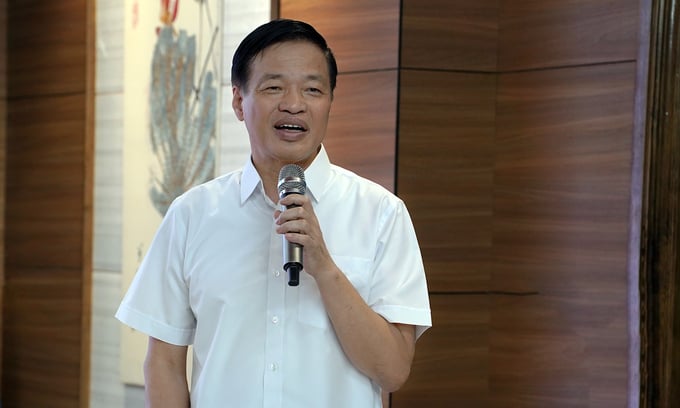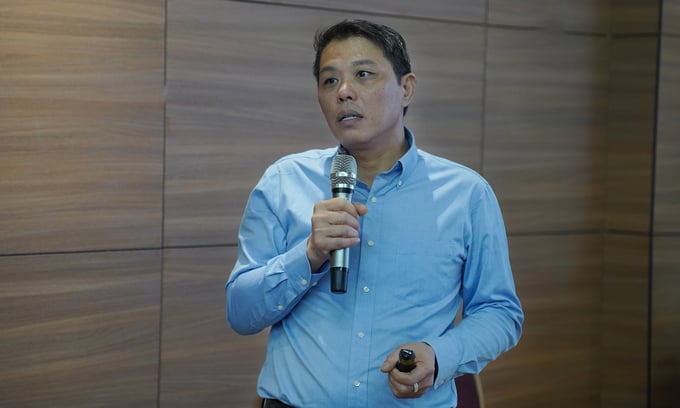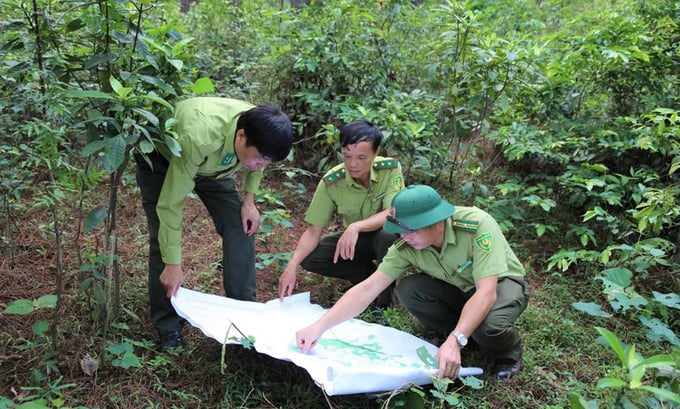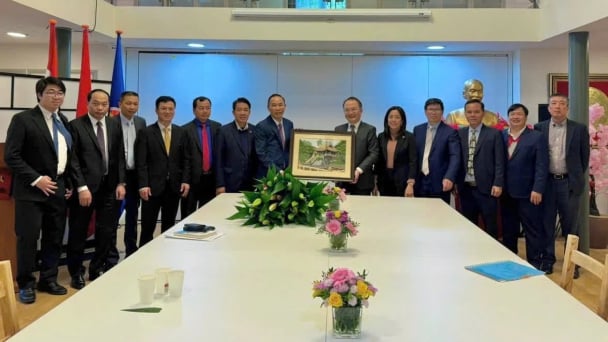June 15, 2025 | 09:27 GMT +7
June 15, 2025 | 09:27 GMT +7
Hotline: 0913.378.918
June 15, 2025 | 09:27 GMT +7
Hotline: 0913.378.918

Prof. Dr. Vo Dai Hai: 'From the moment a tree is planted, forest owners already know how many carbon credits they will generate.' Photo: Bao Thang.
Carbon benefits in forestry are gradually being concretized through legal frameworks via various programs and initiatives that incentivize efforts to reduce greenhouse gas emissions from deforestation and forest degradation, as well as enhance carbon absorption through afforestation and forest restoration.
The Ministry of Agriculture and Rural Development (MARD) has implemented three result-based payment programs in the forestry sector to reduce emissions and increase carbon absorption: (i) The North Central Emission Reduction Program (ERP): This program has transferred 10.3 million tons of CO2, (ii) The LEAF Program: Expected to transfer 6 million tons of CO2 through emission reduction activities in the South-Central Coast and Central Highlands regions, (iii) Participation in the Green Climate Fund's (GCF) Pilot Program for REDD+ Results-Based Payments: Covering the period 2014-2018, with detailed proposals supported by JICA and expected to be submitted by 2025.
Dr. Vu Tuan Phuong, Director of the Sustainable Forest Management Certification Office (VFCO), stated that with commitments to emission reductions aligned with the climate goals of the Paris Agreement, countries are intensifying the implementation of mitigation measures.
On a global scale, the carbon market is growing robustly and diversifying, particularly the compliance carbon market. Vietnam is currently developing a domestic carbon market, a vital tool to facilitate trading, exchange, and offsetting of carbon credits among domestic businesses. Additionally, investments in Vietnam are shifting toward green financing, emphasizing investment in green growth and low-carbon development.
However, Vietnam faces several challenges and barriers in achieving emission reduction goals, including: the lack of detailed regulations on carbon rights and carbon property rights, mechanisms for benefit-sharing and investment incentives, limited capacity for measuring, reporting, and verifying (MRV) emission reduction projects and carbon trading programs, challenges at the local level, particularly for forest owners.
To capitalize on opportunities for financial resources from carbon benefits in forestry and contribute to the nation’s emission reduction targets, Dr. Phuong recommends, "Forestry development strategies and plans at all levels should align with the objectives of generating forest carbon credits and promoting sustainable forest management, ensure technical capacity, transparency, and openness of information and data to support MRV processes, and diversify and enhance the efficiency of investments in forest protection and development programs."

Dr. Vu Tan Phuong: 'Prioritize carbon credit generation and sustainable forest management in all forestry Pprograms and plans.' Photo: Bao Thang.
Recognizing this issue, the Forest Economic Research Center (Vietnam Forestry Science Institute) has collaborated with the Forestry Department of Yen Bai Province to pilot a model for carbon business readiness from planted forests in Yen Binh District (FCBMO project). This pilot is based on an established forest plantation zone numbering system. Through the digital technology application of the iTwood system, the database of forest plantation areas with identification codes will be set up in 4 communes covering 5,000 hectares.
The FCBMO project has several key objectives, including organizing and developing a legal wood supply chain and traceability on 5,000 hectares of planted forests. It also aims to develop a measurement, reporting, and verification (MRV) method, designed to be applied in the iTwood system, to determine the carbon absorption and storage capacity of planted forests.
Based on real data from this research, the FCBMO project will continue to calculate reference carbon levels, establish monitoring criteria and indicators for carbon asset management of household forests, as well as emission reduction results. It will also develop a payment mechanism for carbon services from planted forests. Based on this, the project will quantify certified emission reductions, serving as the basis for determining carbon credits at the project scale, which can be traded once a carbon market is established.
Mr. Hoang Lien Son, Director of the Forest Economic Research Center, shared that there are five main activities in the two-year pilot phase of the FCBMO project. The first step is to apply the digital technology of the iTwood system to develop a legal wood supply chain and traceability system in line with the EUDR, setting up a pilot model on a 5,000-hectare forest with assigned codes. During this phase, the Center will finalize training materials and organize iTwood software training sessions for forest owners and members of farmers’ associations.
Next, the project will develop a measurement, reporting, and verification (MRV) method using the iTwood system to determine the carbon absorption and storage capacity of planted forests.
“Alongside measuring carbon absorption, we will also coordinate with independent remote sensing evaluations and monitor according to carbon market standards. By the end of the project, the carbon reductions will be certified and converted into carbon credits when a market is available, with the prevailing standards of voluntary carbon markets, such as Gold Standard, CCBA, or PLAN VIVO,” Mr. Sơn said.
In the final phase of the FCBMO project, the Forest Economic Research Center is committed to upgrading and improving the iTwood system software to prepare for the carbon business from planted forests. Expanding the FCBMO model is also part of the plan, based on practical results.
With existing technologies, the Center is confident in circulating carbon credits for forest owners from planted forests for a period of 28 to 35 years. This is an encouraging figure, as the price of carbon credits tends to decrease over time.

Forest rangers investigate forest conditions. Photo: Hong Duc.
Successfully trading carbon credits is one of the key benefits derived from assigning codes to forest plantation areas. Prof. Dr. Vo Dai Hai, Director of the Vietnam Academy of Forest Sciences, stated that the coding system enables the forestry sector to comprehensively and uniformly manage all types of forests nationwide. It also provides a foundation to quantify emission reductions for each timber plantation plot managed by family forest owners.
"From the moment a tree is planted, forest owners can calculate how many carbon credits they hold. Additionally, the legality of harvested timber is ensured throughout the supply chain," he explained, emphasizing that digitizing plantation data also enhances efficiency across related areas such as biodiversity conservation and sustainable forestry development.
According to Mr. Trieu Van Luc, Deputy Director of the Forestry Department, plantation coding, alongside sustainable forest management certification, is a growing trend in the market. "To achieve sustainable production and adapt effectively to new regulations like CBAM and EUDR, transparency and accountability are essential. The higher the standards for Vietnam's plantation forests, the easier it will be for timber and wood products to enter demanding markets," Mr. Luc emphasized.
To advance the pilot program for assigning codes to timber plantation areas, the Deputy Director urged consulting firms to work closely with local stakeholders to effectively communicate the necessity and benefits of forest plantation coding to forest owners. He also recommended expanding the use of information technology to verify and cross-check data regarding land use rights, plot conditions, and ownership during implementation.
Mr. Nguyen Thai Binh, Deputy Director of Yen Bai Provincal Department of Agriculture and Rural Development, noted that accelerating the coding of plantation areas presents significant opportunities for wood processing businesses. It facilitates market expansion, stabilizes export markets, improves access to technology, enhances management capabilities, and raises product quality.
Translated by Kieu Chi

(VAN) The working delegation from the Ministry of Agriculture and Environment conducted an important trip to the Netherlands to strengthen strategic partnerships and sustainable development in the agricultural sector.

(VAN) The letter ‘A Plea from the Ocean’ not only evokes emotion but also awakens the human conscience to the responsibility of protecting life on Earth.

(VAN) The Department of Agriculture in South Africa has announced the country’s first mass vaccination of poultry to prevent local birds from contracting avian influenza.

(VAN) Establishment of the Mekong Delta Regional Agricultural Linkage Center, aiming for a closed value chain, deep processing, trading platforms, and international market connectivity.

(VAN) Gia Lai province has recently recorded 460 rare species of animals and plants, contributing to forest conservation and biodiversity planning in the region.

(VAN) Ms. Caroline Beresford, New Zealand Ambassador to Vietnam, expressed confidence that agricultural cooperation between Vietnam and New Zealand will develop sustainably, be climate-resilient, and promote gender equality.

(VAN) Vietnam reaffirms its commitment to international cooperation in fostering sustainable and responsible fisheries while ensuring resilient livelihoods for small-scale fishing communities.